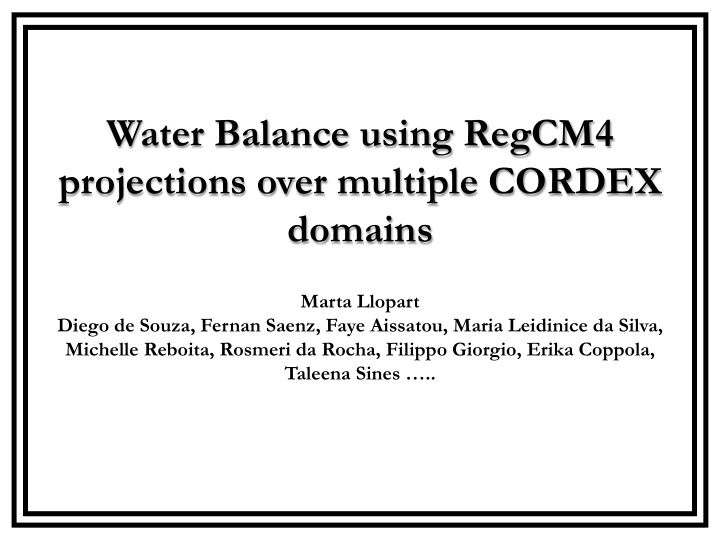



Water Balance using RegCM4 projections over multiple CORDEX domains Marta Llopart Diego de Souza, Fernan Saenz, Faye Aissatou, Maria Leidinice da Silva, Michelle Reboita, Rosmeri da Rocha, Filippo Giorgio, Erika Coppola, Taleena Sines …..
CORDEX domains
The aim is to... ü Understand the water balance change signal in the future Ø Infer whether the water balance are changing and what would be driving this change
Basic Analysis
Model Validation (Reference Period) (c) (a) (b) (d) (e) (f)
Model Validation (Reference Period) (a) (b) (c) (d) (e) (f)
Precipitation Change Signal Llopart et al. (2019) – under review on Climate Dynamics
Temperature Change Signal Llopart et al. (2019) – under review on Climate Dynamics
Water Balance The hydrological cycle describes the cycling of water among land, ocean, and air The cycle has two branches: Ø the terrestrial (inflow, outflow and water storage) and Ø the atmospheric (atmospheric water transport, mainly in the vapor phase).
Water Balance Surface Water Balance Δ S=P-ET-R P= Precipitation (mm day − 1 ) ET= Evapotranspiration (mm day − 1 ) R=Total runoff (mm day − 1 ) Δ S = Soil water content variation (mm day − 1 ) In a long term average, Δ S can be ignored: P=ET+R
Water Balance Atmospheric Water Balance 𝐞𝐱 𝐞𝐱 / 𝐞𝐮 𝐞𝐮 =−𝐐+𝐃+𝐅𝐔 𝐅𝐔 where dw/dt represents the water stock change (mm day − 1 ) P is the precipitation (mm day − 1 ) ET is the evapotranspiration (mm day − 1 ) C is the vertically integrated moisture flux convergence (mm day − 1 ) between 925 and 100 hPa. dw / dt can be ignored for longer periods 𝐅𝐔+𝐃 𝑸 =𝐅𝐔
Water Balance Considering the two branches of the hydrological cycle, the connection between atmosphere and surface is: C = R C= moisture flux convergence R= Runoff
The criteria to define the regions … Ø We will identify the regions where the precipitation, evapotranspiration and moisture flux convergence change signal are significant to perform the analysis Ø And we will try to figure out the causes of these changes
These regions act as moisture sources (sinks) to (from) the atmosphere? Ø According to Marengo et al. (2006) and Nascimento et al. (2016), ET/P ratio is the recycling rate, which indicates how ET contributes to the average rainfall in a given area Ø It can be used as a tool for diagnosing the interactions between the surface and the regional climate
Land surface feedbacks Ø If ET is greater than P locally (ET > P), the region is a source of moisture to the atmosphere Ø To know wheter the precipitation signal is only influenced locally, C must be less than ET (C < ET) Ø In this example the region is a source of moisture locally and for other regions P=8 mm/day ET=10 mm/day Total C = - 2 mm/day
Land surface feedbacks Nascimento et al. (2016)
Land surface feedbacks Ø If ET is greater than P locally (ET > P), the region is a source of moisture to the atmosphere Ø To know whether the precipitation signal is only influenced locally, C must be less than ET (C < ET) Ø In this example the region is a source of moisture only locally P=8mm/day Water storage in the atmosphere (2 mm/day) ET=10mm/day Total C=0
Land surface feedbacks Nascimento et al. (2016)
Remote feedbacks Ø If P>ET locally, the region is a sink of moisture from another region Ø It means that the precipitation signal is mainly driven by remote feedbacks P=10 mm/day ET=4 mm/day Total C = 6 mm/day
Remote feedbacks Nascimento et al. (2016)
If a region is a sink of moisture, we can perform a similar analysis to see where the moisture flux is coming from Integrated Moisture flux ( V q )
𝐅𝐔−𝐃=𝟏 𝑸 −𝐅𝐔 Residual – to close the water balance Ø Residuals may be related to the uncertainties of the models data; Ø In addition, soil moisture must be steady in long periods in order to discard the term ∆ S. If it is not fully acessed, the balance does not close!
What can we obtain from these analysis? How the water balance will behave in the future? What will drive these changes? How the specific regions in the future will behave? Will they still act as a sink (source) of moisture from (to) the atmosphere?
Thank you m.llopart@unesp.br
Recommend
More recommend